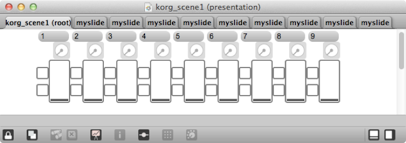Chaos & Fractology - a work in progress

OVerView
The Chaos patch is the evolution of algorithms that use classical fractal equations for producing sound fields that evolve over time as self-organizing systems. The work is a collage extended for performance, installation and web versions.
I am very attracted to the way that fractal structures maintain their integrity across wide dynamics of scale and dimension The nature of these algorithms is to progress into ranges of wide variation and dynamics and settle into regions of small fine motion. The structures maintain acoustic integrity over a wide range volume, frequency, space, number of channels.
The initial implementation was a PD patch that used HENON 2D fractals to control parameters of a synthetic objects used as a studio workbench developed in 2009. Upon starting the patch, the player selects the number of fractal objects which are represented in a crude graph.
The Chaos patch allows a player to select the number of fractal objects to be instantiated and to control various parameters of the mapping to audio using a Korg Nanokontrol.

Basic controls include clock rate of the fractals, distribution to audio channels, gain controls,
selectable switching of the synthetic resonant object.
The orginal PD patch was implemented to include icecast stream to be used for remote presentation and exchange of signals between performers.
Given the broad use of MAX by the group, there’s incentive to port a variant of the patch to that platform as well.
A recent artist statement to be published by the Leonardo Journal is identifies fractal structures as an elemental compositional material as inherent in resonant objects and iterative reticulated systems.
I see the CHAOS patch as a means to establish works using fractal structure as an organizing unifying principle. I’m interested in using a fractal structure to establish, rhythmic, density, textural, timbre, and spatial excursions.
For me now, there is a need to understand the richness of fractal structure and strange attractors in contrast to linear systems and the randomness of rolling the dice.
I have the growing supposition that much of the rich character of resonant objects that has been such a core part of CIE, is made more understandable given the literature of fractals.
The richness of patterns of resonance goes back to Chladni plates that used lycopodium powder and bowed metal plates to visualize resonant nodes. Earlier history is evident in from the luthier’s and violin makers.
One of the fundamental aspects of fractal functions is iterative feedback a form of folding a signal back on itself after some transformation. We use resonance as a form of illumination. The voice and it’s echo combine as a sound in space. Fractology extensions will further unfold sonic character contained these functions. Fractals offer a new vocabulary, new instruments and tuning systems.
SOME BACKGROUND
... references: James Glieck, Peters, Taleb, Peter Oppenheimer’s branches, SIGGRAPH, heart arrythmia, Hurst coefficients, Aswan dam, wave physics, Thors Hammer and compound pendulums, non-newtonian fluids, fluid dynamics, Lorenz, Mandelbrote, Neural Network, Reynolds thresholds ...
“God doesn’t play with dice....” A. Einstein
“No, she uses fractals.” (attributable in my dreams to Benoit Mandelbrote)

